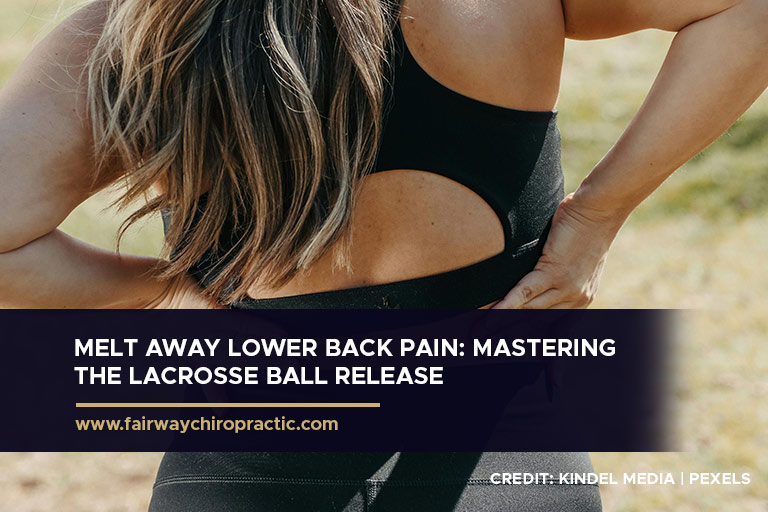Lower back pain is a pervasive issue affecting millions of people globally. In Canada, back problems are among the most common chronic pain conditions. Statistics Canada notes that “Four out of five adults will experience at least one episode of back pain at some time in their lives.”
Often stemming from poor posture, prolonged sitting, or intense physical exertion, lower back pain can significantly hinder one’s quality of life. Fortunately, innovative and straightforward techniques, such as the lacrosse ball release, have emerged as effective remedies. By adopting this technique into your daily wellness plan, you can experience substantial improvements in mobility and pain reduction.
Let us guide you through mastering the lacrosse ball release to combat lower back pain effectively.
Impact of Lower Back Pain
Lower back pain is not just a physical ailment; it affects various aspects of an individual’s life. The following points illustrate the broad-reaching effects of lower back pain:
-
Physical Discomfort and Mobility Restrictions
The most immediate and apparent impact of lower back pain is physical discomfort, ranging from mild, constant aches to sharp, incapacitating pain. This discomfort often leads to restricted mobility, making it difficult to perform daily activities such as bending, lifting, or even walking.
-
Reduced Quality of Life
Persistent lower back pain can significantly reduce one’s quality of life. It may limit participation in recreational activities, hobbies, and exercise, leading to a decrease in overall happiness and satisfaction.
-
Workplace Challenges
Lower back pain is a leading cause of absenteeism and reduced productivity at work. Individuals may find it challenging to maintain focus, perform physical tasks, or sit for prolonged periods, which can impact their professional performance and career progression.
-
Mental Health Concerns
According to the American Psychiatric Association, “People living with chronic pain are at heightened risk for mental health problems, including depression, anxiety, and substance use disorders.”
-
Sleep Disturbances
Many individuals with lower back pain experience difficulty sleeping. The discomfort can make it hard to find a comfortable sleeping position, leading to insomnia or disturbed sleep patterns, which can further exacerbate the condition.
-
Social and Family Life Impact
Lower back pain can strain relationships and social interactions. Pain may prevent individuals from participating in social gatherings, family events, or fulfilling certain roles within the family, leading to feelings of isolation or guilt.
-
Economic Implications
The direct and indirect costs associated with managing lower back pain—medical treatments, lost wages, and reduced productivity—can have significant economic implications for individuals and society as a whole.
The Lacrosse Ball Technique
The lacrosse ball technique is a form of self-myofascial release that targets tight muscles and trigger points in the lower back and other areas of the body. By applying pressure to these points, the technique aims to relieve tension, improve mobility, and promote healing.
-
Equipment Needed
A standard lacrosse ball is used due to its firmness and size, which is ideal for targeting specific areas in the lower back.
-
Identifying Target Areas
Common target areas for lower back pain include the lumbar region, specifically around the erector spinae muscles and the quadratus lumborum.
-
Applying the Technique
The technique involves placing the lacrosse ball on the ground or against a wall and positioning the body so that the ball presses against the targeted area. By gently moving the body, the ball rolls across the muscle, applying pressure and releasing tension.
-
Adjusting Pressure
Users can adjust the amount of pressure applied by changing their body position or by using their hands to press the ball into the muscle. It’s important to apply enough pressure to feel a release but not so much that it causes pain.
-
Duration and Repetition
Spending enough time on each area is important, usually around 30 seconds to 2 minutes per trigger point, allowing the muscle to relax and the fascia to release.
-
Frequency and Duration
For optimal results, aim to perform the lacrosse ball release two to three times per week. Each session should last between 5 to 10 minutes, allowing ample time to work through all areas of tension.
Complementary Practices
Pairing the lacrosse ball release with fitness activities and exercises can further alleviate lower back pain. Here are key practices to consider:
-
Core Strengthening Exercises
Activities that strengthen the core, including the abdominals, lower back, and obliques, support spinal health and reduce the risk of injury. Pilates and yoga are excellent for building core strength and stability.
-
Stretching and Flexibility
Regular stretching can improve flexibility, reduce stiffness, and alleviate tension in the lower back. Incorporate dynamic stretching before activities and static stretching afterwards.
-
Cardiovascular Exercise
Low-impact cardio, such as walking, swimming, or cycling, can improve blood circulation, aid in weight management, and reduce stress on the lower back.
-
Chiropractic Adjustments
Regular chiropractic care can help correct spinal alignment, improve posture, and enhance overall musculoskeletal health.
-
Mindfulness and Relaxation Techniques
Practices like meditation, deep breathing exercises, and progressive muscle relaxation can help reduce stress, which is often a contributor to muscle tension and pain.
-
Proper Ergonomics
Adopting an ergonomic workstation design and maintaining proper posture during daily activities can prevent strain and support spinal health.
Precautions and Considerations

When implementing techniques such as the lacrosse ball release to manage lower back pain, certain precautions and considerations are crucial to ensure safety and effectiveness:
-
Consult a Healthcare Professional
Before starting any self-treatment regimen for lower back pain, consult with a healthcare professional, such as a chiropractor, to ensure the technique is appropriate for your specific condition.
-
Avoid Direct Pressure on the Spine
Direct pressure on the spine or bony prominences can cause injury. Always focus the lacrosse ball on the muscular tissues surrounding these areas.
-
Recognize Pain Thresholds
It’s important to distinguish between the discomfort associated with muscle release and pain that signals harm. If an exercise causes sharp or severe pain, stop immediately and consult a professional.
-
Start Gradually
Begin with light pressure and short sessions. Gradually increase the intensity and duration as your body adjusts to the technique.
-
Use Proper Equipment
Ensure the lacrosse ball is of good quality and appropriate for the technique. A ball that is too hard or too soft may not provide the desired therapeutic effect.
-
Listen to Your Body
Pay attention to your body’s responses during and after the exercise. Discontinue any activity that causes worsening symptoms and seek professional advice.
-
Hydration and Nutrition
Proper hydration and nutrition support muscle recovery and overall spine health. Ensure you’re drinking plenty of water and consuming a balanced diet rich in anti-inflammatory foods.
-
Regular Assessment
Regularly assess your condition and the effectiveness of the technique. If lower back pain persists or worsens, consider seeking further evaluation and treatment options from healthcare professionals.
Mastering the lacrosse ball release presents a cost-effective and efficient method to combat lower back pain, enhance flexibility, and improve overall well-being. Remember, consistency and attentiveness to your body’s needs are paramount in this journey towards pain-free living.
For those seeking additional support in their quest for relief from lower back pain, Fairway Chiropractic Centre offers a range of services tailored to meet individual health goals. With a commitment to providing a great standard of care, our team is dedicated to helping you regain mobility and enjoy a life free from pain.
Contact us at 519-748-5535.











